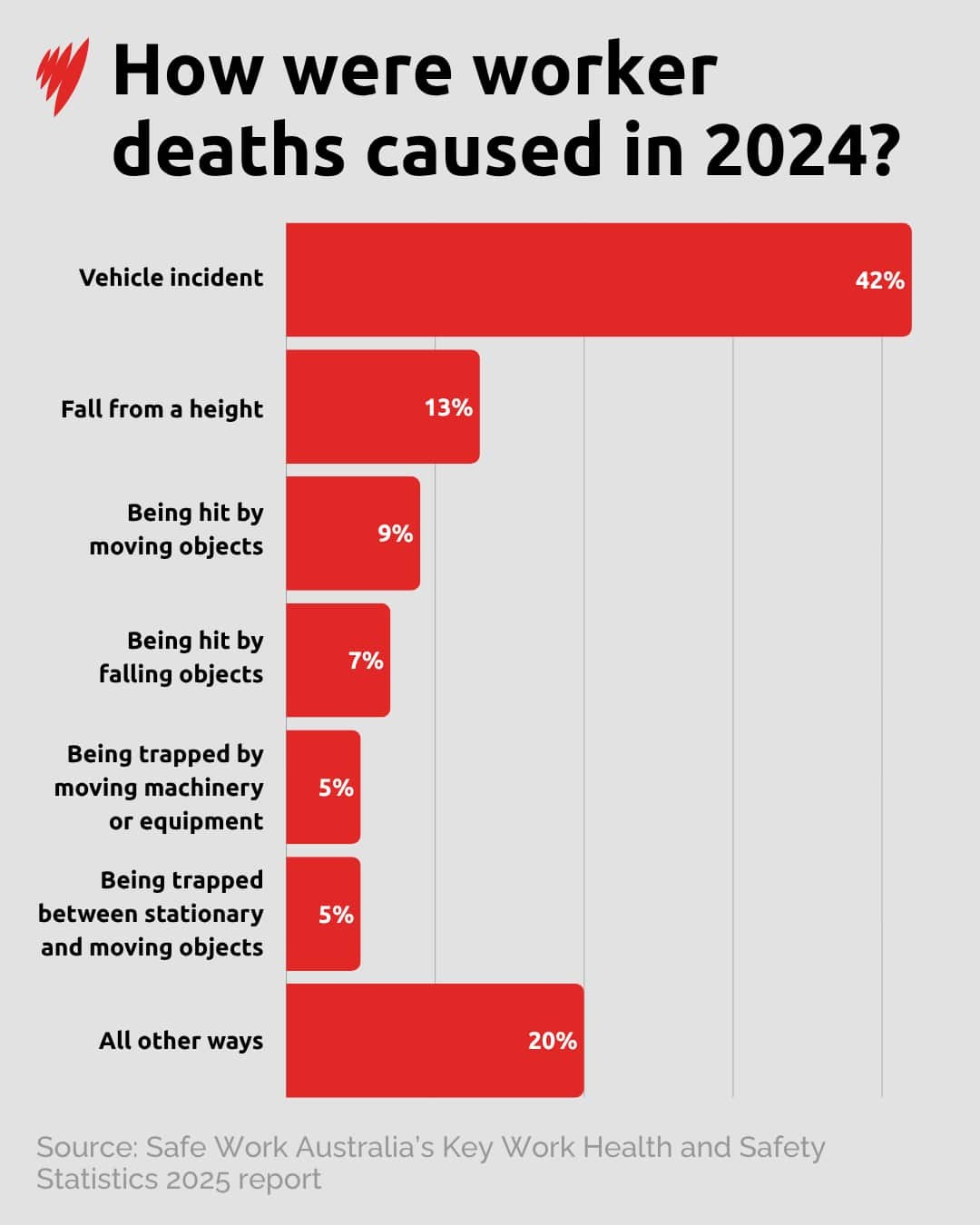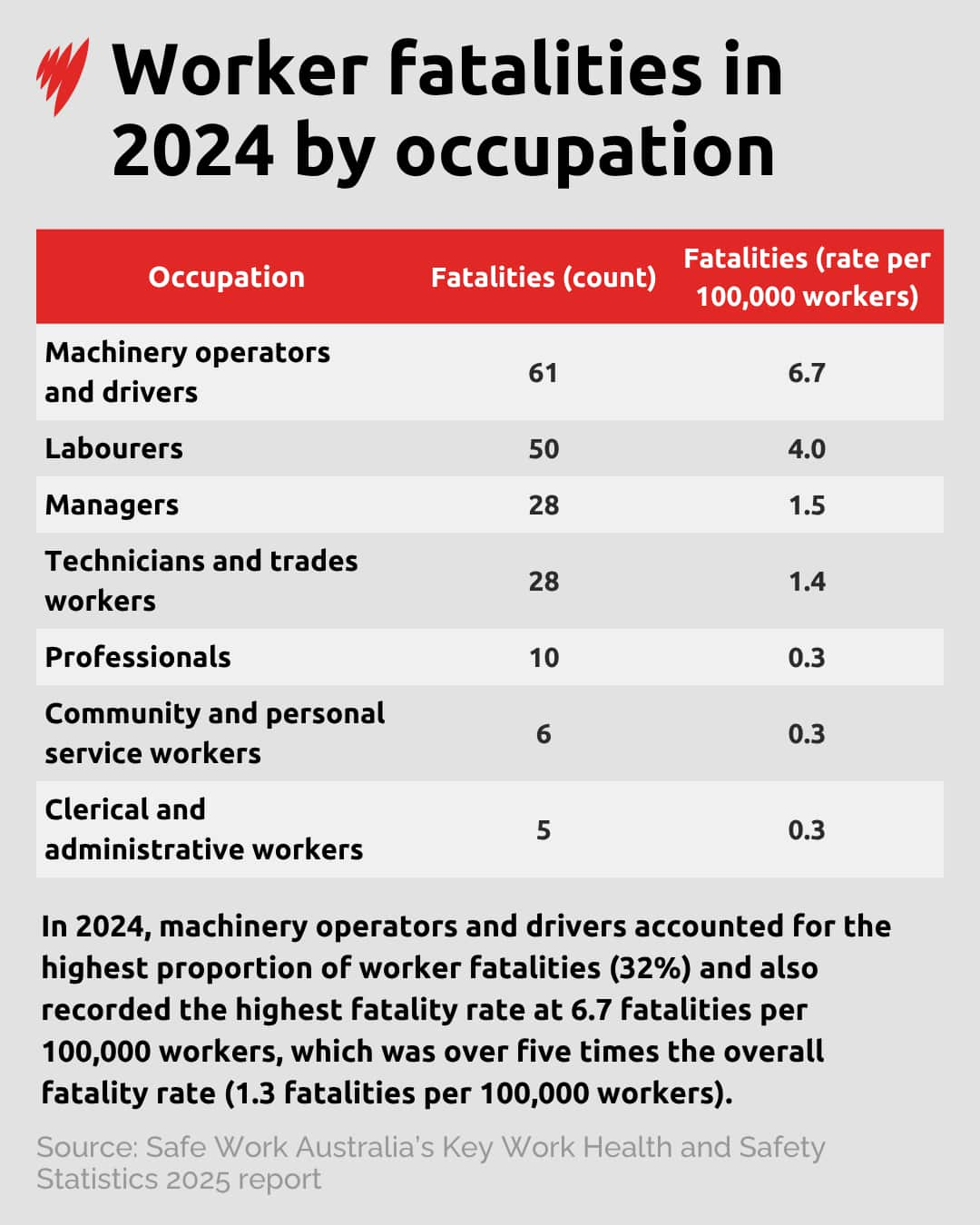A third of jobs accounted for more than half of Australia's serious work injury claims in 2024, while only three in 10 injured workers across the entire workforce reported receiving workers' compensation.
Safe Work Australia's Key Work Health and Safety Statistics Australia report for 2025, released on Friday, revealed 188 workers died from traumatic injuries while working in Australia in 2024, with a rate of 1.3 deaths per 100,000 workers.
Over the past decade, that figure has decreased by 24 per cent, from a rate of 1.7 fatalities per 100,000 workers in 2014.
Workers aged 45 and over accounted for more than half of worker fatalities recorded.
Australia's peak body representing workers, the Australian Council of Trade Unions (ACTU), said while a fall in the fatality rate is welcome, 188 families still lost a loved one last year.

Vehicle incidents accounted for 42 per cent of worker fatalities in 2024. Source: SBS News
"One death at work is one too many, and our job is far from done."
There were 146,700 serious workers' compensation claims involving at least one week or working time lost in 2023-2024 — more than 400 serious claims a day.
What did the report find?
Safe Work Australia's report found four sectors collectively made up more than half of the 146,700 serious workers' compensation claims in 2024.
Those industry divisions were health care and social assistance (19.9 per cent), construction (12 per cent), manufacturing (10.1 per cent) and public administration and safety (9.2 per cent).
However, those sectors only represented 36.3 per cent of filled jobs covered by a workers' compensation scheme.
Overall, across all industries, three in 10 injured workers reported receiving workers' compensation, while the rest either did not lodge a claim or did not receive compensation.
The ACTU expressed alarm that seven in 10 injured workers were not receiving compensation, citing barriers in reporting and under-reporting that obscured the actual cost of workplace injuries across Australia.
When it came to fatalities, machinery operators and drivers represented 61 worker deaths in 2024, with a rate of 6.7 fatalities per 100,000 workers. This was followed by labourers (50 fatalities), managers, technicians and trades workers (28 fatalities).

In 2024, machinery operators and drivers accounted for the highest proportion of worker fatalities (32 per cent) and also recorded the highest fatality rate at 6.7 fatalities per 100,000 workers, according to the report. Source: SBS News
Vehicle incidents were by far the most common cause of death at 42 per cent, and at least one vehicle was directly involved in the incident in 66 per cent of worker fatalities in 2024.
Other causes of death included falls from a height (13 per cent), being hit by moving objects (9 per cent), being hit by falling objects (7 per cent), and being trapped by moving machinery or equipment or between stationary and moving objects (both 5 per cent).
Workers aged 45 and over accounted for more than half of worker fatalities recorded.
Mental health claims on the rise
The report also found that over the past decades, serious claims for mental health conditions have experienced the largest change across any major injury group, with a 161 per cent increase.
Mental stress is now the fourth most common cause of serious claims, at 11.5 per cent.
The median time lost from serious claims related to mental stress is about five times the median time lost across all serious claims and leads to significantly more time off work.
Mental health claims also represented the costliest form of workplace injury — leading to more than four times the median compensation paid across all serious claims.
While men accounted for the vast majority of deaths (180) in 2024 and accounted for 58 per cent of all serious claims, the report found women's serious claims were more than twice as likely to involve mental health conditions as men's.
On average, women's claims also involved more time away from work. Median compensation paid for serious claims remains 20.4 per cent higher for men — $17,600 to $14,600.
The ACTU said unions were calling for greater legislative protection for workers who were exposed to psychosocial hazards on the job, such as violence and aggression, sexual harassment and discrimination.
O'Brien said: "Employers must treat work stress and intensification with the same seriousness as any other health and safety consideration."
Share


